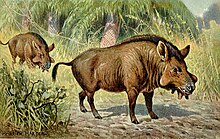Entelodontidae
| Entelodon | |
|---|---|

| |
| Scientific classification | |
| Kingdom: | |
| Phylum: | |
| Class: | |
| Order: | |
| Family: | Entelodontidae
|
| Genera | |
Entelodonts are an extinct, omnivorous group of mammals distantly related to modern pigs and other hoofed animals. They ranged across Asia and North America 45 to 25 million years ago. Some stood seven feet (2.1 m) tall and had a brain the size of a fist. They were scavengers (they ate dead animals) and they also ate plants. They appear to have had a pig-like lifestyle. Some were the size of a small modern rhinoceros.
Partial skeletons are commonly found in the Hsanda Gol fossil beds of Mongolia, but there are much better preserved and very similar fossils found in North America.
Many of their skulls have very severe wounds, some have gashes up to 2 cm deep in the bone between the eyes that could only have been inflicted by other entelodonts during conflict. In fact it seems to have been quite common for one to fit another's head entirely in its mouth. The bony lumps all over their faces, like those of modern warthogs, were perfectly placed to protect delicate areas during these fights. This seems to have worked well as even very scarred entelodonts show no damage to the protected eyes or nose. Their huge skulls were enormously powerful and designed to crush bones. Many teeth-marked bones are found in fossil beds with entelodonts. They were clearly biased toward the scavenger role and probably ate any dead or helpless animal that they came across. Their thickly enamelled teeth are often broken, and also show marks suggesting they chewed vines and exposed roots for water in the dry season.
Entelodonts probably followed huge herds of prehistoric mammals, eating the dead and rounding off their diet with plant material. Sick, old, lame or wounded large animals would have been finished off and eaten by them as well. Some argue that entelodonts could kill healthy prey in a true predator role. See the Daeodon Web link below and refer to Archaeotherium, a small entelodont about the size of a cow.
In general though, they were probably too smelly, and too noisy to have made good predators on fast plains mammals. They are best thought of as omnivores and scavengers. They certainly also killed and ate small slow animals, such as snakes and baby birds, eggs, turtles and the like.
Entelodonts probably spent much time driving true predators such as Hyaenodon (a Creodont) off their kills. They were well equipped to do this, especially if they traveled in packs.
External links
- http://www.abc.net.au/beasts/factfiles/factfiles/entelodont.htm Video, images & sound
- http://cdm.lib.uiowa.edu/cdm4/item_viewer.php?CISOROOT=/geoscience&CISOPTR=34&REC=1 Entelodont Skeleton
- http://www.abc.net.au/beasts/evidence/prog3/page4.htm Another image, some more info and a link to a Q&A page
- http://www.keltationsart.com/Daeodon.htm
- http://www.avph.hpg.ig.com.br/dinohyus.htm
